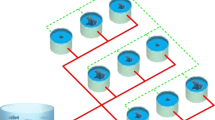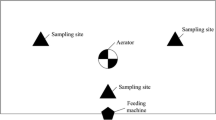Abstract
Pond cultivation of the subtropical, euryhaline macroscopic red algaGracilaria tenuisipitata var.liui Zhanget Xia was carried out in brackish seawater (6–7‰) in the Gryt archipelago on the east coast of Sweden, using four outdoor tanks of 30–40 m3. Growth rate and nutrient uptake in batch culture were measured with the aim of estimating the water purification capacity ofG. tenuisipitata in outdoor conditions. Its ability to withstand epiphytic infections was also studied. An average growth rate of 4‰ biomass increase per day was recorded during two seasons with a maximum growth rate of 9‰ d−1. The initial biomass was usually 1 kgFW m−3 (FW, fresh weight). The nutrient uptake capacity was on average ca. 1 g Ni kgFW−1 d−1 and 0.08 g Pi kgFW−1 d−1 and the uptake rates for NH4 +-N were higher than those for NO3 −-N. Both the growth rate and the nutrient uptake rate were highest at the highest water temperature. Co-cultivation with rainbow trout (Oncorhynchus mykiss) was tested: with trout fodder as the only nutrient inputG. tenuistipitata could grow and maintain low levels of Ni and Pi with optimum efficiency at a trout: alga ratio of 1:1 (w:w). Epiphytic growth of filamentous green and brown algae was limited, probably as a result of the high pH values caused by inorganic carbon uptake byG. tenuistipitata. The growth ofEnteromorpha intestinalis, the only significant epiphyte, was completely inhibited and the majority of plants died by a few days treatment with 100 µg 1−1 Cu2+, a concentration that did not severely affectG. tenuistipitata. We conclude thatG. tenuistipitata can be cultivated in outdoor ponds in southern Sweden during 5–6 months of the year using aerated or unaerated batch cultures and that wastewater from trout cultivation may be used as a nutrient source, resulting in purification with respect to N and P.
Similar content being viewed by others
References
Ackefors H, Enell M (1990) Discharge of nutrients from Swedish fish farming to adjacent sea areas. Ambio 19: 28–35.
Antia NJ, Harrison PJ, Oliveira L (1991) The role of dissolved organic nitrogen in phytoplankton nutrition, cell biology and ecology. Phycological reviews 11. Phycologia 30: 1–89.
Asare SO (1980) Animal waste as a nitrogen source forGracilaria tikvahiae and Neoagardhiella baileyi in culture. Aquaculture 21: 87–91.
Axelsson L, Uusitalo J (1988) Carbon acquisition strategies for marine macroalgae I. Utilization of proton exchanges visualized during photosynthesis in a closed system. Mar. Biol. 97: 295–300.
Bidwell RGS, McLachlan, J Lloyd NDH (1985) Tank cultivation of Irish moss,Chondrus crispus Stackh. Bot. Mar. 28: 87–97.
Chiang YM (1981) Cultivation ofGracilaria (Rhodophycophyta, Gigartinales) in Taiwan. In Levring T (ed.), Proceeding of Xth International Seaweed Symposium. Walter de Gruyter & Co., Berlin, New York, 569–574.
Cohen I, Neori A (1991)Ulva lactuca biofilters for marine fishpond effluent. I. Ammonia uptake kinetics and nitrogen content. Bot. Mar. 34: 475–482.
DeBoer JA, Guigly HJ, Israel TL, D'Elia CF (1978) Nutritional studies of two red algae. I. Growth rate as a function of nitrogen source and concentration. J. Phycol. 14: 261–266.
DeBusk TA, Ryther JH (1984) Effects of seawater exchange, pH and carbon supply on the growth ofGracilaria tikvahiae (Rhodophyceae) in large-scale cultures. Bot. Mar. 27: 357–362.
D'Elia CF, DeBoer JA (1978) Nutritional studies of two red algae. II. Kinetics of ammonium and nitrate uptake. J. Phycol. 14: 266–272.
Evans LV (1981) Marine algae and fouling: a review, with particular reference to ship-fouling. Bot. Mar. 24: 167–171.
Friedlander M, Ben-Amotz A (1991) The effect of outdoor culture conditions on growth and epiphytes ofGracilaria conferta. Aquat. Bot. 39: 315–333.
Friedlander M, Galai N, Farbstein H (1990) A model of seaweed growth in an outdoor culture in Israel. In Lindstrom SC, Gabrielson PW (eds), Thirteenth International Seaweed Symposium. Developments in Hydrobiology 58. Kluwer Academic Publishers, Dordrecht, 367–373. Reprinted from Hydrobiologia 204/205.
Fujita RM (1985) The role of nitrogen status in regulating transient ammonium uptake and nitrogen storage by maroalgae. J. Exp. Mar. Biol. Ecol. 92: 283–301.
Goodman C, Newall M, Russell G (1976) Rapid screening for copper tolerance in ship-fouling algae. Int. Biodetn. Bull. 12 (3): 81–83.
Haglund K, Pedersén M (1988) Spray cultivation of seaweeds in recirculating brackish water. Aquaculture 72: 181–189.
Haglund K, Pedersén M (1992) Growth of the red alga Gracilaria tenuistipitata at high pH. Influence of some environmental factors and correlation to an increase carbonic-anhydrase activity. Bot. Mar. in press.
Hanisak MD, (1987) Cultivation ofGracilaria and other macoralgae in Florida for energy production. In Bird KT, Benson PH (eds), Seaweed Cultivation for Renewable Resources. Developments in Aquaculture and Fisheries Science 16. Elsevier, Amsterdam/Oxford/New York/Tokyo, 191–218.
Hanisak MD, Ryther JH (1986) The experimental cultivation of the red seaweed Gracilaria tikvahiae as an ‘energy crop’: an overview. In Barclay WR, McIntosh RP (eds), Algal Biomass Technologies. Beih. Nova Hedwigia 83. J. Cramer, Berlin, 212–217.
Harlin MM (1978) Nitrate uptake byEnteromorpha spp. (Chlorophyceae): applications to aquaculture systems. Aquaculture 15: 373–376.
Harlin MM, Thorne-Miller B, Thursby GB (1979) Ammonium uptake byGracilaria sp. (Florideophyceae) andUlva lactuca (Chlorophyceae) in closed system fish culture. In Proc. Int. Seaweed Symp. 9: 285–292.
Krom MD, Neori A (1989) A total nutrient budget for an experimental intensive fishpond with circularly moving seawater. Aquaculture 83: 345–358.
Lapointe BE (1987) Phosphorus- and nitrogen-limited growth ofGracilaria tikvahiae (Rhodophyceae) in the Florida Keys: an experimental field study. Mar. Biol. 93: 561–568.
Lapointe BE, Ryther JH (1978) Some aspects of the growth and yield ofGracilaria tikvahiae in culture. Aquaculture 15: 185–193.
Lapointe BE, Ryther JH (1979) The effects of nitrogen and seawater flow rate on the growth and biochemical composition ofGracilaria foliifera var.angustissima in mass outdoor culture. Bot. Mar. 22: 529–537.
Lehnberg W, Schramm W (1984) Mass culture of brackishwater-adapted seaweeds in sewage-enriched seawater I. Productivity and nutrient accumulation. In Bird CJ, Ragan MA (eds), Eleventh International Seaweed Symposium. Developments in Hydrobiology 22. Dr W. Junk Publishers, The Hague, 276–281. Reprinted from Hydrobiologia 116/117.
Lewis AG, Metaxas A (1991) Concentrations of total dissolved copper in and near a copper-treated salmon net pen. Aquaculture 99: 269–276.
Lignell Å (1988) Physiology and cultivation of marine seaweeds with emphasis on Gracilaria secundata (Rhodophyta, Gigartinales). Acta Universitatis Upsaliensis 120: 48 pp. Uppsala. ISBN 91-554-2148-2.
Lignell Å, Pedersén M (1987) Nitrogen metabolism inGracilaria secundata Harv. In Ragan MA, bird CJ (eds), Twelfth International Seaweed Symposium. Developments in Hydrobiology 41. Dr W. Junk Publishers, Dordrecht, 431–441. Reprinted from Hydrobiologia 151/152.
Lignell Å, Ekman P, Pedersén M (1987) Cultivation technique for marine seaweeds allowing controlled and optimized conditions in the laboratory and on a pilotscale. Bot. Mar. 30: 417–424.
Liu SJ (1987) Study on the commercial cultivation ofGracilaria in south China. Chin. J. Oceanol. Limnol. 5: 281–283.
Markager S, Sand-Jensen K (1990) Heterotrophic growth ofUlva lactuca (Chlorophyceae). J. Phycol. 26: 670–673.
Mohanty N, Vass I, Demeter S (1989) Copper toxicity affects photosystem II electron transport at the secondary quinone acceptor, QB. Plant Physiol. 90: 175–179.
Murphy J, Riley JP (1962) A modified single solution method for the determination of phosphate in natural waters. Analyt. Chim. Acta 26: 31–36.
Neish AC, Shacklock PF, Fox CH, Simpson FJ (1977) The cultivation ofChondrus crispus. Factors affecting growth under greenhouse conditions. Can. J. Bot. 55: 2263–2271.
Neori A, Cohen I, Gordin H (1991)Ulva lactuca biofilters for marine fishpond effluent. II. Growth rate, yield and C:N ratio. Bot. Mar. 34: 483–489.
Prince JS (1974) Nutrient assimilation and growth of some seaweeds in mixtures of sea water and secondary sewage treatment effluents. Aquaculture 4: 69–79.
Provasoli L (1968) Media and prospects for the cultivation of marine algae. In Watanabe A, Hattori A (eds), Cultures and Collections of Algae. Proceedings US — Japan Conf, Hakone, Jpn. Soc. Plant. Physiol., 63–75.
Ryther JH (1977) Preliminary results with a pilot-plant waste recycling-marine aquaculture system. In D'Itri FM (ed.), Wastewater Renovation and Reuse. Marcel Dekker, Inc., New York and Basel, 90–132.
Ryther JH, Corwin N, Debusk TA, Williams LD (1982) Nitrogen uptake and storage by the red algaGracilaria tikvahiae (McLachlan, 1979). Aquaculture 26: 107–115.
Ryther JH, DeBoer JA, Lapointe BE (1979) Cultivation of seaweeds for hydrocolloids, waste treatment and biomass for energy conversion. Proc. Int. Seaweed Symp. 9: 1–16.
Rönnberg O, Ådjers K, Ruokolahti C, Bondestam M (1992) Effect of fish farming on growth, epiphytes and nutrient content ofFucus vesiculosus L. in the Åland archipelago, northern Baltic Sea. Aquat. Bot. 42: 109–120.
Santelices B, Doty MS (1989) A review ofGracilaria farming. Aquaculture, 78: 95–133.
Shang YC (1976) Economic aspects ofGracilaria culture in Taiwan. Aquaculture 8: 1–7.
Solórzano L (1969) Determination of ammonia in natural waters by the phenolhypochlorite method. Limnol. Oceanogr. 14: 799–801.
Thomas TE, Harrison PJ (1987) Rapid ammonium uptake and nitrogen interactions in five intertidal seaweeds grown under field conditions. J. Exp. Mar. Biol. Ecol. 107: 1–8.
Tseng CK (1981) Commercial cultivation. In Lobban SC, Wynne MJ (eds), The biology of seaweeds. Botanical Monographs Vol. 17. Blackwell Scientific Publications, Beccles and London, 680–725.
Ugarte R, Santelices B (1992) Experimental tank cultivation ofGracilaria chilensis in central Chile. Aquaculture 101: 7–16.
Wood ED, Armstrong FAJ, Richards FA (1967) Determination of nitrate in seawater by cadmium-copper reduction to nitrite. J. mar. biol. Assoc. U.K. 47: 23–31.
Zhang JF, Xia BM (1988) On two new Gracilaria (Gigartinales, Rhodophyta) from south China, In Abbott IA (ed.), Taxonomy of economic seaweeds, with reference to some Pacific and Caribbean species, Vol. II, California Sea Grant College Program, University of California, La Jolla, CA., 131–136.
Author information
Authors and Affiliations
Rights and permissions
About this article
Cite this article
Haglund, K., Pedersén, M. Outdoor pond cultivation of the subtropical marine red algaGracilaria tenuistipitata in brackish water in Sweden. Growth, nutrient uptake, co-cultivation with rainbow trout and epiphyte control. J Appl Phycol 5, 271–284 (1993). https://doi.org/10.1007/BF02186230
Received:
Revised:
Accepted:
Issue Date:
DOI: https://doi.org/10.1007/BF02186230




